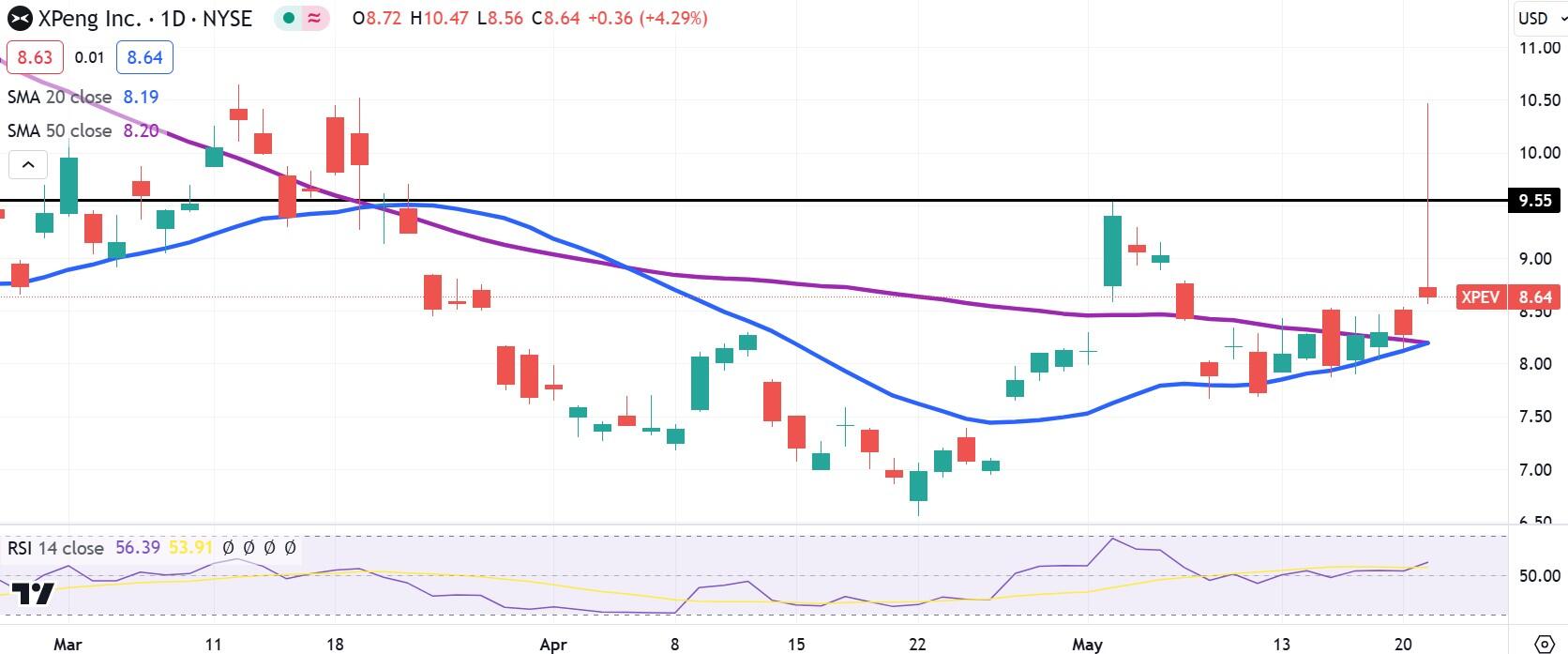XPeng earnings show that Chinese EV market is shifting into higher gear

- XPeng beats Q1 earnings and sales targets from Wall Street analysts.
- XPEV stock rises as much as 26% following earnings release.
- Deliveries are rising swiftly this year with further good news for Q2.
- Management expects +48% annual revenue growth in Q2.
XPeng (XPEV) stock spiked more than 26% at Tuesday’s open following the Chinese electric vehicle (EV) maker’s quarterly earnings. XPeng showed there was definitive light at the end of a dark tunnel for the Chinese EV sector.
XPeng’s exciting morning run gave up quickly, however, and XPEV stock has retained a 6% gain into the afternoon session. The Dow Jones, S&P 500 and NASDAQ have all registered slight gains, while competitor Nio (NIO) gains less than 1%.
XPeng earnings news
XPeng reported adjusted earnings per American depository share (EPADS) of $-0.21, three cents better than Wall Street had expected. Those better results came on the heels of $910 million in revenue for the first quarter that bested consensus by more than 7% or $60 million.
It was already known prior to the earnings release that XPeng deliveries in Q1 had risen by 20% compared to a year earlier. April deliveries of 9,393 tell us that this growth is only gaining steam.
What’s more, XPeng management expects deliveries to surge to between 29,000 and 32,000 in the second quarter. That would mean YoY delivery gains between 25% and 38%. Revenue should likewise advance between 48% and 64% YoY, according to the guidance.
“Notwithstanding significant market competition, our first quarter gross margin expanded substantially to 12.9%, doubling from the previous quarter with an increase of 6.7 percentage points,” said XPeng CEO and Chairman Xiaopeng He. “This development underscores Xpeng’s innovative approach to enhancing profitability and international market potential through the provision of smart technologies based on its Smart EV business. This has created a completely new unique model.”
EV stocks FAQs
Electric vehicles or EVs are automobiles that use rechargable batteries and electric motors to accelerate rather than internal combustion engines (ICEs). They have been around for more that 100 years, but battery technology research & development was meager for much of the 20th century. Lithium-ion battery technology became advanced enough to produce EVs at scale in the late 1990s and 2000s, and sales have been steadily increasing since then Tesla’s Roadster was unveiled in 2008. EVs are viewed as a means of reducing carbon emissions since battery electric vehicles (BEVs) themselves produce zero emissions. Other vehicles called plug-in hybrid electric vehicles (PHEVs) utilize both battery electric power and ICEs as a backup.
EVs are growing from a small base, but they rose from 9% of global new auto sales in 2021 to 14% of the total in 2022. This was a 65% YoY growth rate, and the industry delivered 10.2 million EVs worldwide in 2022. Projections show this number climbing above 16 million in 2023. Across the world, market shares differ greatly among nations. Nearly 88% of Norwegian new car sales in 2022 were EVs. On the other hand, the United States, where much of the modern innovation in EVs was forged, had less than 8% of new vehicle sales go to EVs in 2022. The largest EV market in the world, China, saw 30% of the market go to EVs that year.
We know you’re thinking Elon Musk, but he’s probably more like the father of the mass-market, contemporary EV. All the way back in 1827, a Hungarian priest named Anyos Jedlik invented the electric motor and used it the following year to power a vehicle of sorts. French scientist Gaston Planté invented the lead-acid battery in 1859, and German engineer Andreas Flocken built the first true electric car for the public in 1888. EVs made up about 38% of all vehicles sold in the US around 1900. They began losing market share rapidly after 1910 when gasoline-powered vehicles grew much more affordable. They largely died off until new research programs in the 1990s led to gradual private sector investment in the 2000s.
China’s BYD is by far the largest manufacturer of EVs in the world. In 2022 it sold 1.8 million EVs and in the second half of the year made up 20% of the global market. The asterisk given to BYD is that the vast majority of these vehicles are hybrids. Tesla’s 12% market share is often treated as more significant than BYD, because it only sells BEVs and is the most famous EV brand in the world. Volkswagen, BMW and Wuling then round out the top five. As a new sector with heavy investment though, many startups have flooded the market. These include China’s Nio, Li Auto and Xpeng; a Swedish-Chinese manufacturer called Polestar; and Lucid and Rivian from the US.
XPeng stock forecast
XPeng’s morning rally petered out at $10.47, just before the $10.50 price level that caused resistance for the stock back in March. It is good that XPEV stock is returning to 2-month highs, but it is also worrisome that shares sold off so resolutely. It appears that many shareholders of the ADS want out.
The 20-day and 50-day Simple Moving Averages (SMAs) have been narrowing their separation for the past month, and on Tuesday they landed right on top of each other. This might signal to us that the rally will continue from here despite the midday sell-off.
Prior support/resistance at $9.55 did not hold, and bulls will surely keep this level in mind as shares appreciate over the next month.
XPEV daily stock chart
